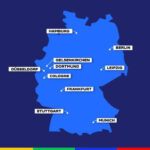Euro banknotes are the tangible representation of the Euro currency, used daily by millions across the Eurozone. Understanding the different denominations and series of these banknotes is essential for anyone living in, traveling to, or doing business with Europe. Currently, there are two series of euro banknotes in circulation, each with distinct designs and security features. This guide provides a detailed overview of both series, helping you to identify and understand the euro banknotes in your wallet.
The Europa Series Euro Banknotes
The Europa series is the second and current series of euro banknotes, designed to be more durable and secure than the first series. It is named after Europa, a figure from Greek mythology, whose portrait is featured in the watermark and hologram of each banknote. This series includes six denominations, ranging from €5 to €200.
5 Euro Europa Banknote
The €5 euro banknote is grey in color and measures 120 x 62 mm. Its design represents the Classical architectural period, reflecting Europe’s rich history and heritage.
10 Euro Europa Banknote
The €10 euro banknote is characterized by its red color. Slightly larger than the €5 note, it measures 127 x 67 mm and showcases the Romanesque architectural style, another key period in European art and architecture.
20 Euro Europa Banknote
The blue €20 euro banknote is 133 x 72 mm in size. Its design is inspired by the Gothic architectural period, known for its grandeur and intricate details found in many European cathedrals.
50 Euro Europa Banknote
The orange €50 euro banknote is larger, measuring 140 x 77 mm. It features the Renaissance architectural style, symbolizing a period of rebirth and innovation in European history.
100 Euro Europa Banknote
The green €100 euro banknote measures 147 x 77 mm and represents the Baroque and Rococo architectural styles, known for their ornate and dynamic forms.
200 Euro Europa Banknote
The yellow €200 euro banknote is the largest in the Europa series, at 153 x 77 mm. Its design showcases Iron and glass architecture, reflecting 19th-century industrial innovation and modern European structures.
The First Series Euro Banknotes
The first series of euro banknotes was introduced in 2002. Although gradually being replaced by the Europa series, these banknotes are still legal tender. The first series originally included seven denominations, from €5 to €500.
5 Euro First Series Banknote
Similar to the Europa series, the €5 euro banknote in the first series is grey and measures 120 x 62 mm. It also features the Classical architectural period in its design.
10 Euro First Series Banknote
The red €10 euro banknote of the first series is 127 x 67 mm and also showcases the Romanesque architectural style, mirroring the theme in the Europa series for this denomination.
20 Euro First Series Banknote
The blue €20 euro banknote in the first series is 133 x 72 mm, continuing with the Gothic architectural theme found in the equivalent Europa series note.
50 Euro First Series Banknote
The orange €50 euro banknote of the first series measures 140 x 77 mm and also depicts the Renaissance architectural period.
100 Euro First Series Banknote
The green €100 euro banknote in the first series is slightly longer at 147 x 82 mm compared to the Europa series. It represents the Baroque and Rococo architectural styles.
200 Euro First Series Banknote
The yellow €200 euro banknote of the first series is also longer at 153 x 82 mm. It continues to feature Iron and glass architecture.
500 Euro First Series Banknote
The purple €500 euro banknote, unique to the first series, is the largest at 160 x 82 mm. It represents Modern 20th-century architecture. Although production of the €500 banknote ceased in 2019, it remains legal tender.
Legal Tender and the Future of Euro Banknotes
It’s important to note that all banknotes from the first series, including the €500 note, are still legal tender throughout the Eurozone. This means they can be used for payments and as a store of value. While the first series is being phased out, they remain valid.
Looking ahead, the Eurosystem is actively developing a new series of euro banknotes, with citizens playing a key role in the design process. “European culture” and “Rivers and birds” have been selected as potential themes for these future banknotes. The final designs and the timeline for production and issuance are expected to be decided by the European Central Bank (ECB) in 2026, signaling an exciting evolution for euro banknotes.
In conclusion, understanding the current series and denominations of euro banknotes, as well as their historical context and future developments, is crucial for anyone interacting with the Euro currency. Both the Europa and first series banknotes represent not just currency, but also aspects of European history and culture, making them fascinating symbols of European unity.


